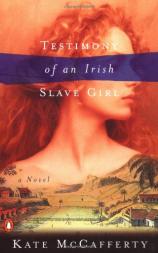Reading Group Guide
Discussion Questions
Testimony of an Irish Slave Girl

1. How surprising was it to learn that in the seventeenth century the British Empire captured thousands of Irish men, women, and young boys—"tinkers, jugglers, peddlers, wanderings, idle laborers, loiterers, beggars, and such as could not give a good account of themselves" (p. vii)—and shipped them to work as slaves in the Indies? How does this historical episode alter your understanding of more recent conflicts between the British and the Irish?
2. Why does Kate McCafferty choose to tell this story in the voice of Cot Daley? Why has she structured her narrative around Cot's forced testimony to Peter Coote? What affects does McCafferty achieve through letting us see slave life in Barbados and the failed rebellion of 1675 through Cot's recollection of them?
3. Cot comes from a long line of seanachies, storytellers who "traveled the world in all its strangeness and brought back its songs, its tales and poetry and wisdom" (p. 5). In what ways is Cot herself a kind of poet? Why does she insist on telling her story the way she wants to tell it, filled with digressions of all kinds, instead of simply giving Coote the information he's after?
4. What kind of man is Peter Coote? What were his ambitions in coming to Barbados? In what ways is he like Cot Daley? At what points in the novel does he feel empathy and connection with her?
5. When Coote asks Cot if she "reported Mary Dove's plot because she had borne false witness against you?" Cot replies: "No! None of us had the right to tell the truth....The truth was the creation of our masters" (p. 70). In what sense do masters create the truth? How does Testimony of an Irish Slave Girl itself attempt to subvert the truth such masters have created?
6. Why does Cot betray the first slave rebellion against Sir Henry Plackler? Why does she so willingly participate in the Coromantee uprising of 1675? How has she changed in the intervening years?
7. What experiences lead Cot to stop identifying with her masters and begin to see the connections between herself and the African slaves? What does she find she has in common with the Africans? Why are the masters so worried about just such connections?
8. Testimony of an Irish Slave Girl is a historical novel about Barbados in the seventeenth century, but how is the story it tells relevant to our own time and place? What larger truths does it reveal about human motivations and human relationships? In what sense does Quashey's spirit live on?
9. Cot tells Coote that "every tribe of people think themselves the yardstick of Creation, and feel fear and distaste and suspicion of outsiders. But still, I tell you this is learned....In right circumstances, things like that melt away like morning haze" (p. 45). Do you agree with Cot's assessment of the origins of prejudice in the above passage? How does the novel dramatize this idea?
10. At the very end of the novel, when Peter Coote's son sends the manuscript of Cot's testimony to Betty, the narrator tells us that "he hears God laughing. But that's another tale: a tale not recorded here" (p. 204). Why would God laugh at the transmission of this story? How would the tale of that laughter unfold? Why has McCafferty chosen to end her novel in this way?
Testimony of an Irish Slave Girl
- Publication Date: January 28, 2003
- Paperback: 240 pages
- Publisher: Penguin (Non-Classics)
- ISBN-10: 014200183X
- ISBN-13: 9780142001837







